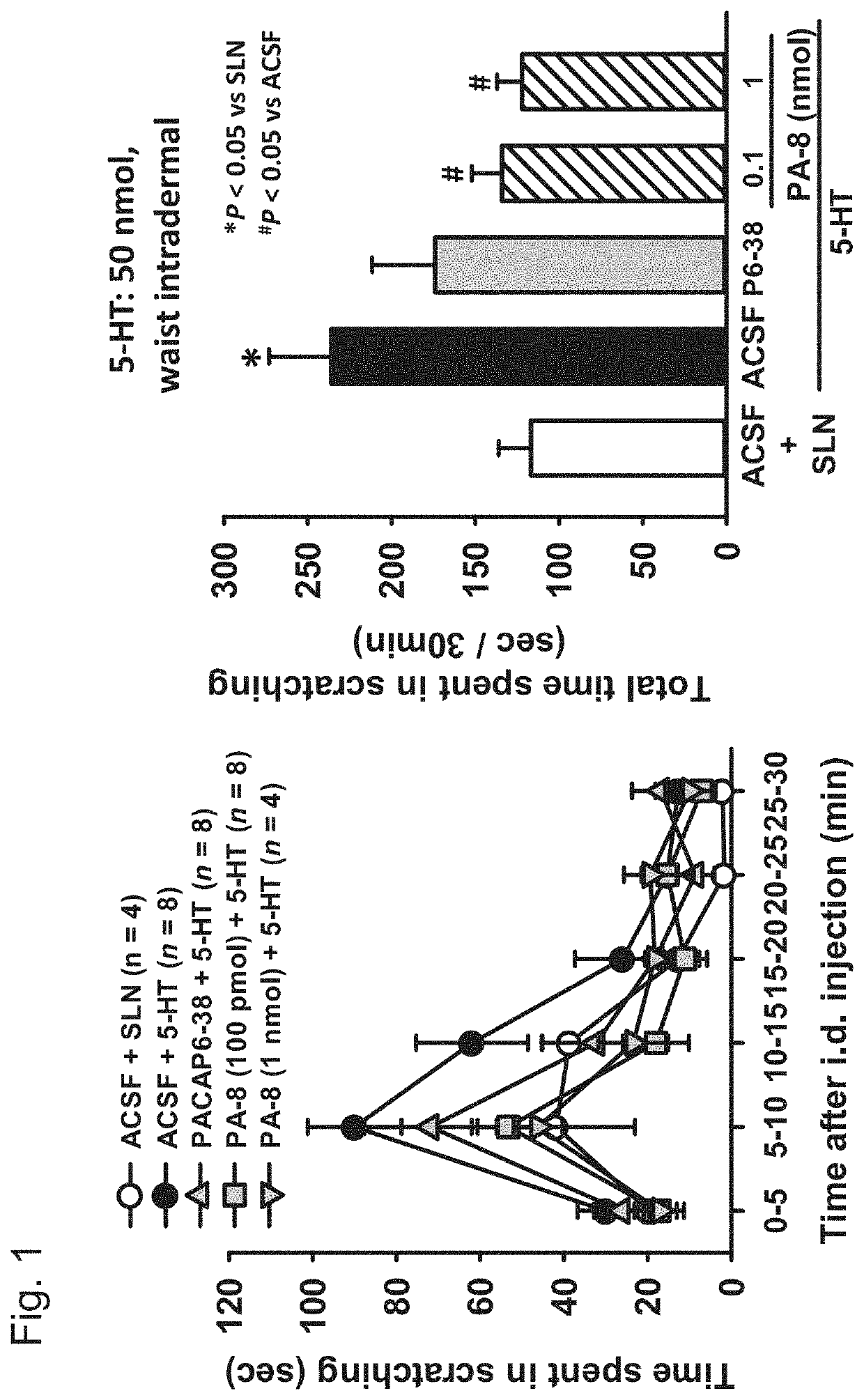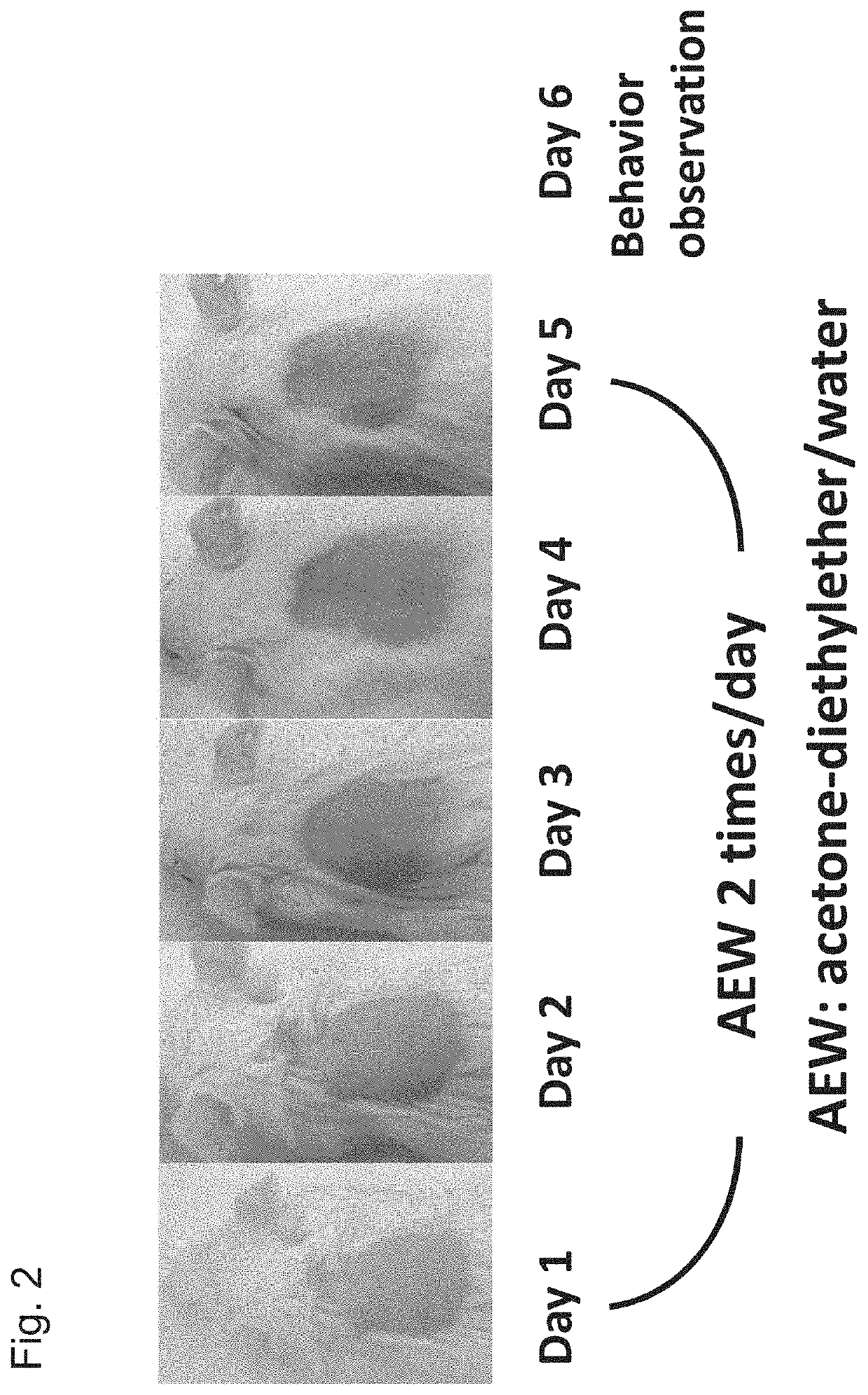Antipruritic agent using pac1 receptor antagonist
a technology of pac1 receptor and antipruritis, which is applied in the direction of dermatological disorders, drug compositions, immunological disorders, etc., can solve the problems of insufficient effect of antihistamine on itch, inability to use steroid or cyclosporin for a long period of time, and approximately 30% of patients treated with tacrolimus topical drugs cannot achieve sufficient effect, etc., to achieve the effect of reducing the necessity of combined use, high effect and improving quality
- Summary
- Abstract
- Description
- Claims
- Application Information
AI Technical Summary
Benefits of technology
Problems solved by technology
Method used
Image
Examples
example 1
[Example 1] Synthesis of pyrido[2,3-d]pyrimidine Derivatives
[0081]
[0082]To a solution of the corresponding aldehyde (1.00 mmol) from the commercial aldehydes (1a, b, d, e, f, g, j, k, m, n, o, p, q and r) and the aldehydes known in Literatures (1c, h, i, 1, s and t) in ethylene glycol (0.5 mL) were sequentially added at room temperature 2,4-diamino-6-hydroxypyrimidine (0.67 mmol) and Meldrum's acid (1.00 mmol), and the mixture was stirred at 100° C. for 20 hours in an Ar atmosphere in accordance with a method described in Literature 1). The reaction liquid was let to cool, then filtered, and further washed with methanol (0.5 mL×3) to obtain pale yellow crystals 2a to u, respectively.
2-Amino-5-(4-ethoxy-3-methylphenyl)-5,8-dihydro-3H,6H-pyrido [2,3-d]pyrimidine-4,7-dione (2a)
[0083]Yield: 46%; mp: >300° C.; IR (KBr): 3455, 3166, 2856, 2699, 1578, 1477 cm−1; 1H NMR (400 MHz, DMSO-d6): δ 10.55 (1H, br s), 10.01 (1H, s), 6.90 (1H, d, J=2.4 Hz), 6.84 (1H, dd, J=8.8, 2.4 Hz), 6.77 (1H, d, ...
example 2
[Example 2] Synthesis of PA-9 Derivatives
[0112]
[0113]The corresponding amine from the amines 1a to d (1.0 eq) and itaconic acid (1.0 eq) were mixed at room temperature, and the mixture was heated gradually from 60° C. to 150° C. in an Ar atmosphere in accordance with Literature 1) (JP 2006-510596 A). The mixture was heated at 150° C. for 30 minutes and then cooled to room temperature to obtain carboxylic acids 2a to d, respectively, as pale yellow solids. To a solution of the corresponding carboxylic acid from the carboxylic acids 2a to d (1.0 eq) in DMF were sequentially added at room temperature dicyclohexylcarbodiimide (DCC) (1.2 eq), 1-hydroxybenzotriazole (HOBt) (1.2 eq) and histamine (1.2 eq), and the mixture was stirred for 15 hours. A crude product was obtained by distilling off the solvent, and the crude product was purified by silica gel chromatography (CH2Cl2:MeOH=5:1) and further washed with EtOAc:MeOH=5:1 (0.5 mL×3) to obtain 3a to d, respectively, as white solids.
1-(4-...
example 4
[Example 4] Drug Efficacy Evaluation Using the Dry Skin Itch Mouse Model
[0148]The present test was carried out with reference to the method of Miyamoto et al. that is a test system published as a method for evaluating itch in animals (Miyamoto T., Nojima H., Shinkado T., et al.: Itch-associated response induced by experimental dry skin in mice, Jpn. J. Phamacol., 88, 285-292, 2002).
[0149]Five-week-old ICR mice (40 mice) were each placed in a cage, and were then conditioned for 1 week. Thereafter, three days before initiation of the test, the rostral back of each mouse was shaved (treatment method A). The thus shaved 40 mice were divided into 5 groups (8 mice / group), namely, into a 3 mg / kg PA-8 oral (p.o.) administration group, a 10 mg / kg PA-8 oral (p.o.) administration group, a 30 mg / kg PA-8 oral (p.o.) administration group, a comparative group, and a control group.
PA-8 Administration Groups
[0150]In the PA-8 administration groups, the mice, which had undergone a shaving treatment (t...
PUM
| Property | Measurement | Unit |
|---|---|---|
| weight | aaaaa | aaaaa |
| temperature | aaaaa | aaaaa |
| temperature | aaaaa | aaaaa |
Abstract
Description
Claims
Application Information
 Login to View More
Login to View More - R&D
- Intellectual Property
- Life Sciences
- Materials
- Tech Scout
- Unparalleled Data Quality
- Higher Quality Content
- 60% Fewer Hallucinations
Browse by: Latest US Patents, China's latest patents, Technical Efficacy Thesaurus, Application Domain, Technology Topic, Popular Technical Reports.
© 2025 PatSnap. All rights reserved.Legal|Privacy policy|Modern Slavery Act Transparency Statement|Sitemap|About US| Contact US: help@patsnap.com



